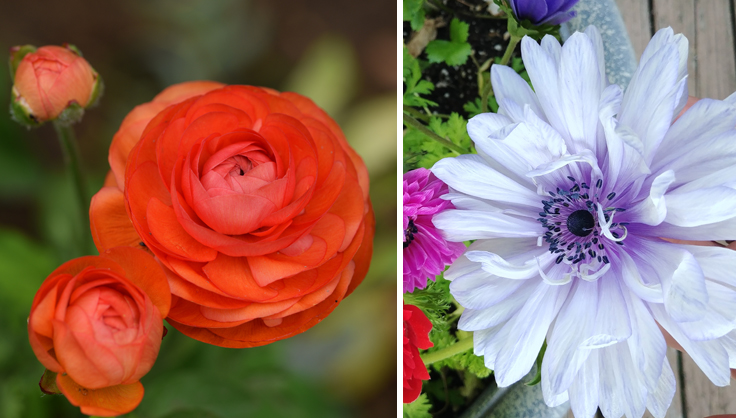How to Grow Ranunculus and Anemone
Despite their strange and clumsy names, ranunculus and anemone are some of the most exquisite blooms to grace the garden. With their layers of luscious, tissue-paper thin petals, ranunculus flowers resemble roses. They come in a rainbow of colors from soft peaches and pinks to bold burgundies. Anemone are grown in cheery shades of purple, pink, blue, and white, often with a dark center eye that gives them a poppy-like appearance. Both are coveted by florists for their unique coloring and long vase life.
Both ranunculus and anemone sprout from corms, a funky looking bit of stem tissue. Corms are similar to bulbs, in that both are underground storage structures that contain nutrients and food for plant growth. Crocus and gladiolus are other examples of corms, while tulips and daffodils are bulbs.
 Photo: Ranunculus(left), Anemone(right)
Photo: Ranunculus(left), Anemone(right)Growing either of these beauties takes a little prep, but don’t despair! Let's walk you through it:
- Soak the corms in clean, room temperature water for 3-4 hours. Stir them occasionally to aerate the water. You may see the corms plump up as they absorb water. Oversoaking the corms will cause them to rot, so set a timer and don’t forget about them!
- Place the soaked corms in a shallow tray filled with potting soil and set the tray up in a cool location for 2 weeks. Be sure to plant the corms with their tips facing up. This is known as “presprouting” and it will give your plants a jumpstart on flowering. Keep the soil moist, but do not overwater – again, don’t risk rot!
- Once the corms have sprouted little white rootlets and a few green leaves, they are ready to be planted in a container or directly in the garden. Both of these plants enjoy rich, well-drained soil, in an area that receives full sun, although they will tolerate some shade.
Timing is everything. For mild climates (USDA hardiness zone 8 and higher), corms can be presprouted and planted outside mid fall, for blooms in winter. Ranunculus and anemone are generally considered "tender perennials", even though they are grown as annual flowers in most regions of the United States.
In colder areas (USDA zones 3-7), begin presprouting in early March for late spring blooms. Regardless of location, cover your ranunculus and anemone plants with frost cloth when temperatures dip below freezing. Both plants enjoy cool weather but cannot tolerate a hard freeze.
Print this Article:
Get the Dirt
Stay up to date on new articles and advice. Please fill out the information below.

